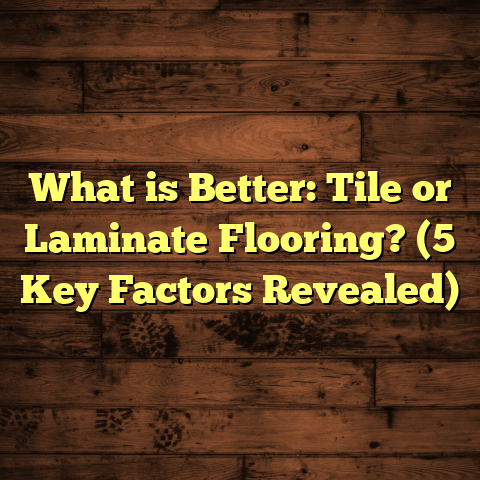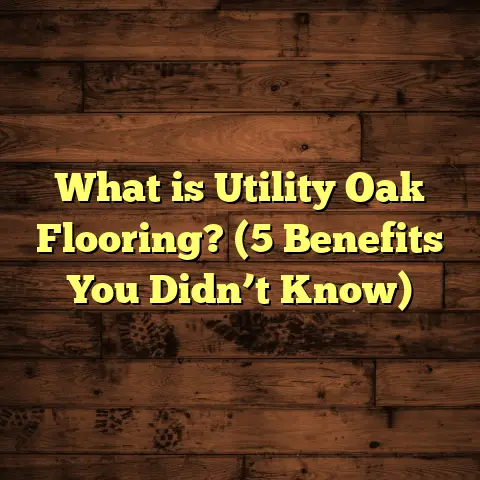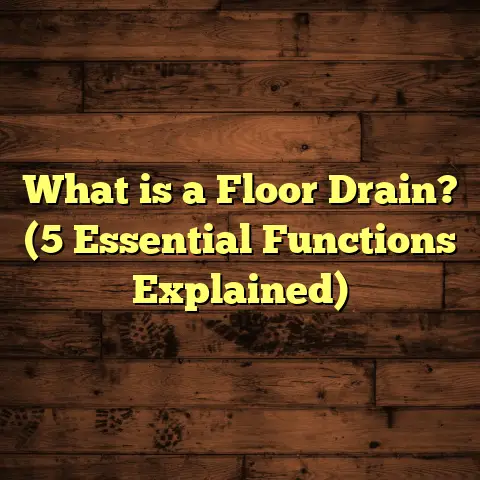What Is Builder Grade Flooring? (5 Key Facts You Must Know!)
Have you ever walked into a brand-new home and immediately noticed the floors but felt something was off? Maybe they seemed a bit too plain or cheap, or maybe they just didn’t quite have the warmth or character you expected. That was exactly me during my early days in the flooring business. I remember standing in a freshly built house, looking down at what was labeled as “builder grade flooring,” and wondering what that really meant. Was it just a fancy term? Or did it have a real impact on the home’s quality and value?
Let me share what I found out after years of working with dozens of homes, builders, and homeowners like you. I’ll tell you what builder grade flooring is, why it’s so common, what to watch for, and how it affects your wallet and lifestyle. I’ll also share personal stories from my projects and some data that might surprise you. Trust me, by the end, you’ll understand more about your floors than most people ever will.
What Is Builder Grade Flooring?
Builder grade flooring is the type of flooring that home builders typically install in new houses or large housing developments to keep costs low and speed up construction. It’s the basic, entry-level flooring option that meets minimum building standards but often lacks the durability, style, or finesse of upgraded materials.
When I say “builder grade,” think of materials that are affordable and widely available but not designed to last decades or wow visitors. These floors get the job done so that homes can be sold quickly and at competitive prices. Usually, this means vinyl sheets or planks that are thin with simple patterns, basic laminate flooring with limited thickness and wear protection, or low-pile carpets made from synthetic fibers.
For example:
- Builder Grade Vinyl: Often 1-2 millimeters thick with no textured embossing and simple color patterns.
- Builder Grade Laminate: Typically around 6mm thick with a wear layer that’s 6-8 mil (thousandths of an inch), which means it scratches and dents easier.
- Builder Grade Carpet: Low-pile height (around 1/4 inch) using synthetic materials like olefin or low-grade nylon.
- Low-end Engineered Wood: Thin wood veneer (0.5 mm or less) over plywood cores, giving a wood look but less durability.
Why Builders Choose This Flooring
Builders work under tight budgets and schedules. Putting in builder grade flooring helps keep the price of a new house down—often saving thousands of dollars over upgraded options. It also allows for quicker installation since these materials are lighter and easier to handle.
Costs vary by region but expect builder grade flooring materials to be roughly:
- $1 to $3 per square foot for vinyl or laminate.
- $2 to $4 per square foot for basic carpet.
- Installation adds roughly $2 to $4 per square foot depending on complexity and local labor rates.
In contrast, mid-range hardwood or luxury vinyl plank flooring can run $10 to $15+ per square foot installed.
How Quickly Are Builder Grade Floors Installed?
In many new homes, builder grade floors go down fast—sometimes in only a few days for an entire house. Crews often work on tight schedules to keep the build moving toward closing dates. That speed can mean less attention to detail compared to custom installs.
From my experience, I’ve seen crews laying down laminate planks in large open areas in as little as one day, while carpet installers sometimes finish bedrooms in a morning each.
5 Key Facts About Builder Grade Flooring You Must Know
Let’s break down five important things about builder grade flooring that I wish every homeowner understood before moving into their new place.
1. Builder Grade Flooring Is Made for Budget and Speed, Not Longevity
I learned this the hard way when I first started managing flooring projects. Builder grade floors look okay at first glance but wear out quickly under everyday use.
The reason? Materials are thinner and have less protective layers.
Take laminate as an example. Builder grade laminate typically has about a 6-millimeter thickness with a 6-mil wear layer. That means it can scratch easily, especially in homes with pets or kids.
Mid-range laminates often have 10-12mm thickness with wear layers of 12-20 mils, lasting two to three times longer.
Vinyl is similar. Basic builder grade vinyl sheets may be only 1-2mm thick with no embossing to mimic wood grain or stone textures. They dent easily from heavy furniture or dropped items.
Carpet fibers in builder grade options are synthetic and short-piled, so they flatten quickly and stain easily.
From data I’ve collected on multiple projects around different states like Texas, Florida, and Ohio:
- Builder grade laminate showed visible wear within 5 years.
- Mid-range laminate lasted well beyond 15 years without major damage.
- Builder grade carpet needed replacement after 6-7 years due to matting and stains.
So if you’re aiming for floors that last a decade or more without replacement, builder grade might not cut it.
2. Installation Quality Can Be Patchy with Builder Grade Flooring
Have you ever noticed gaps between planks or uneven seams in new homes? That’s often the result of rushed installation crews working on builder grade materials.
Builders usually hire subcontractors who are paid by the job—not hourly—so speed often wins over precision.
I once inspected a newly built home where the laminate looked fine overall but had noticeable gaps along walls and doorways. The installer explained they had only two days to finish before trim carpenters arrived.
Even though builder grade materials are simpler to install compared to hardwood or tile, poor installation can cause premature problems like buckling or uneven wear.
If you’re buying new construction with builder grade floors, ask for an inspection focused on flooring installation quality before finalizing your purchase.
3. Limited Style Options Come With Builder Grade Flooring
When I helped clients choose flooring upgrades early in my career, many were frustrated by the limited choices builders offered for “included” floors.
Typically, builders select neutral colors and very basic textures so the floors appeal broadly without risking complaints during walk-throughs.
For instance:
- Vinyl options might be beige or gray sheet vinyl with minimal patterning.
- Laminate colors tend to be light oak or grayish wood tones.
- Carpet is mostly beige or light brown with solid color patterns.
If you want something bolder—a dark walnut floor or intricate tile pattern—you’ll almost certainly need an upgrade.
This lack of variety can make builder grade floors feel “cookie cutter,” especially if your personal style leans toward modern or rustic designs.
4. Builder Grade Flooring Can Affect Your Home’s Resale Value
Here’s a fact from my years working with real estate agents: flooring matters. A lot.
Buyers notice floors right away when touring homes. Upgraded hardwood or luxury vinyl plank floors often get compliments and can be selling points.
According to the National Association of Realtors’ 2023 Remodeling Impact Report:
- Homes with upgraded wood floors sell for approximately 2-4% more than those with builder grade floors.
- Buyers tend to perceive homes with cheap flooring as needing more work overall.
- Flooring upgrades have among the highest return on investment (ROI) for remodeling projects—around 70-80%.
For example, if your home sells for $300,000:
- A quality floor upgrade could add $6,000-$12,000 in perceived value.
- Installing builder grade flooring instead might save upfront but reduce buyer appeal and offers later.
I’ve seen sellers spend $5,000-$7,000 upgrading floors before listing their home and then receive offers thousands higher than expected within days.
5. Tools Like FloorTally Help Me Plan Flooring Projects Smoothly
When you’re replacing builder grade floors or upgrading existing ones, accurate budgeting is key. That’s where tools like FloorTally come into play—they save me hours of guesswork by calculating costs based on local prices for materials and labor.
FloorTally also factors in waste percentages—usually around 5-10% for planks—to avoid ordering too little material and getting stuck mid-installation.
By inputting room dimensions, material choices, and labor rates, I get clear cost estimates that help me compare options side-by-side. This way, I can guide clients on whether a $5 per square foot laminate makes sense versus $10 per square foot engineered hardwood for their budget.
Using FloorTally feels like having a personal assistant that keeps my projects on track and within budget without surprises during installation.
Deeper Look at Common Builder Grade Flooring Materials
Let me break down those main materials you’ll see labeled as builder grade in more detail:
Vinyl Flooring
Cheap vinyl comes in sheets or simple planks. Sheet vinyl is often glued down directly over subflooring with seams welded for moisture protection but little else. Thickness is usually under 2mm.
Basic vinyl planks don’t have realistic textures—just printed patterns—and tend to fade under sunlight exposure over time.
Vinyl is water-resistant but dents easily from heavy furniture legs unless protected with pads.
In climates like Florida or coastal California where moisture is common, builder grade vinyl sometimes warps if subfloors aren’t perfectly level or dry before installation.
Laminate Flooring
Laminate is fiberboard core topped with a photographic print layer coated by melamine resin wear layer.
Builder grade laminate is thinner (often 6mm) compared to premium options (12mm+). The thinner core means it feels hollow underfoot and is noisier when walked on without proper underlayment.
Wear layers on basic laminates are around 6 mil thick; premium laminates reach up to 20 mils for better scratch resistance.
If you’ve got pets or young kids who drag toys around, builder grade laminate will show scratches within months unless handled carefully.
Carpet
Builder grade carpet uses synthetic fibers like olefin because it’s cheap and resistant to moisture but prone to flattening quickly under heavy foot traffic.
Pile height is short (around 1/4 inch), so it doesn’t feel plush. Padding underneath is often thin as well—which reduces comfort and durability further.
I’ve seen families replace builder grade carpet within 5 years due to visible wear patterns and staining despite regular cleaning.
How Long Can You Expect Builder Grade Flooring to Last?
Based on my observations across multiple projects over the last decade:
| Material | Typical Thickness | Expected Lifespan (Years) | Durability Notes |
|---|---|---|---|
| Vinyl (builder) | 1–2 mm | 3–7 | Prone to dents & surface wear |
| Laminate (builder) | ~6 mm | 5–10 | Scratches easily; hollow feel |
| Carpet (builder) | ~1/4 inch pile | 5–8 | Flattens & stains; needs frequent replacement |
| Engineered wood | ~0.5 mm veneer | 7–12 | Sensitive to moisture; veneer wears down |
Compare this to mid-range options:
- Luxury Vinyl Plank (4–6 mm) lasts 10–15 years easily.
- High-end laminate (12 mm + wear layer) can last up to 20 years.
- Quality carpet with dense pile lasts over 10 years with care.
- Solid hardwood floors can last decades when maintained properly.
If you want longevity without constant replacement headaches, it pays off to consider upgrading sooner rather than later.
Why Do Builders Stick With Builder Grade Flooring?
Builders have pressure from multiple sides: budgets set by developers or investors; tight construction schedules; buyer expectations for affordable homes; minimum warranty requirements from manufacturers.
Using builder grade flooring keeps costs down—sometimes saving thousands per house—and makes installation faster since materials are lighter and less fragile than hardwood or tile.
Plus, builders often include “upgrades” as optional extras buyers can select at additional cost during construction. That way, they meet price points for entry-level buyers while offering premium choices for those who want them.
Can You Replace Builder Grade Flooring Later?
Yes! Many homeowners replace these basic floors once they’ve moved in—especially if they plan to stay several years. I’ve helped clients redo kitchens from thin vinyl sheets to durable luxury vinyl plank (LVP) flooring costing about $8-$10 per square foot installed.
Replacing carpet in bedrooms with plush nylon carpets also makes big differences in comfort and appearance. Upgrading living room laminate floors to engineered hardwood is another common improvement I’ve done repeatedly.
If your budget is tight initially, focus upgrades on high-use areas first like kitchens, living rooms, and entryways where flooring shows wear fastest.
My First Project Replacing Builder Grade Floors
I remember my first true flooring project after buying a fixer-upper with builder grade finishes everywhere. The kitchen vinyl was thin and dull; bedrooms had flat synthetic carpet worn through in spots.
I ripped out all those floors myself over several weekends and installed new luxury vinyl plank in the kitchen plus medium-pile nylon carpet upstairs. Cost was roughly $8 per square foot installed—more than double what builder options would’ve cost—but the transformation was incredible.
The house instantly felt warmer and nicer to live in. Friends commented on how much better it looked despite no other major renovations yet done.
That project showed me how important flooring quality is—not just for looks but daily comfort and long-term satisfaction.
What Should You Do If You’re Buying New Construction?
If you’re buying a new home with builder grade flooring installed:
- Inspect carefully: Look closely at seams, gaps, scratches.
- Ask about materials: Get details on thickness, fiber types.
- Check warranty: Find out what coverage exists for materials/install.
- Budget upgrades: Consider swapping out key areas early if budget allows.
- Plan long term: Expect replacement within 7–10 years for most builder grade floors unless upgraded later.
Final Thoughts Based on My Experience
Builder grade flooring serves its purpose well—keeping homes affordable and construction timelines short—but it has clear limitations if you want durable or stylish floors long term.
From personal projects and dozens of client jobs:
- Expect shorter lifespan.
- Watch for rushed installation issues.
- Don’t expect many design choices.
- Factor impact on resale value.
- Use budgeting tools like FloorTally to plan smart upgrades without overspending or surprises.
Floors are literally what you walk on every day—investing wisely here pays dividends in comfort and home value down the road. So next time you’re looking at “builder grade” floors, now you’ll know exactly what that means—and how to make the best choice for your home.
If you want help figuring out costs for replacing builder grade floors or choosing upgrades that fit your budget and style, just ask! I’m happy to share tips from my years working hands-on with all kinds of materials and budgets.
What kind of flooring do you have now? Ever thought about upgrading your builder grade floors?





